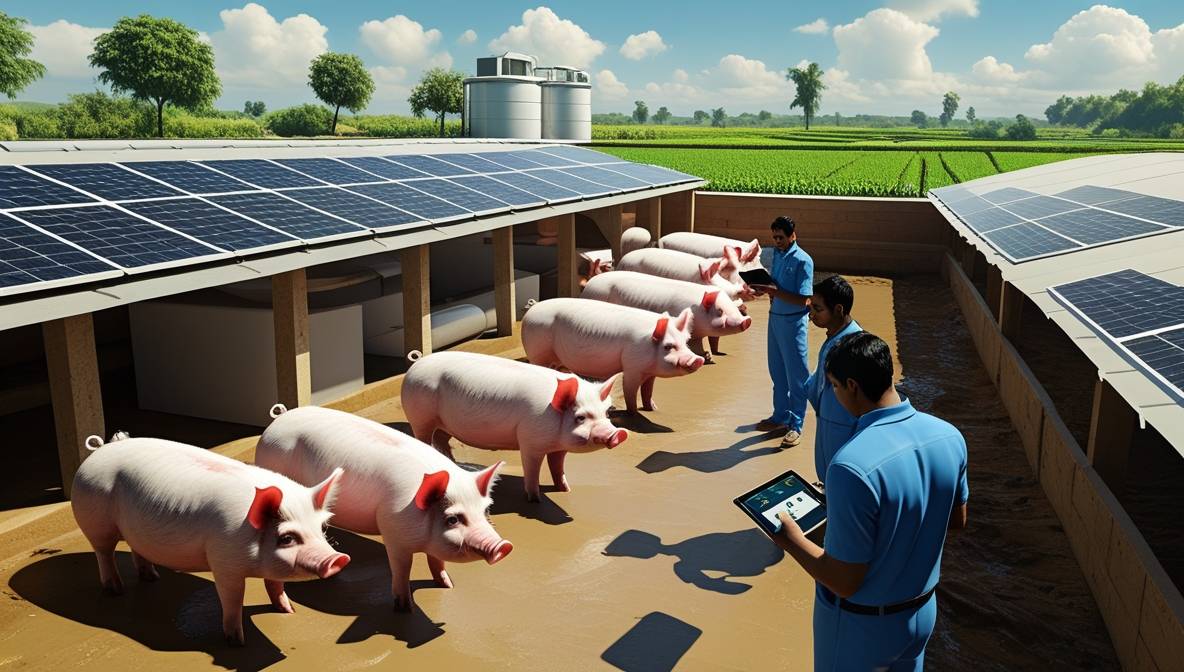Pig farming in India has emerged as a lucrative agribusiness, driven by rising demand for pork, government incentives, and advancements in livestock management. As of 2025, the sector contributes ₹12,800 crores annually to India’s agricultural GDP, with states like Assam, Uttar Pradesh, and Kerala leading production. This guide outlines actionable steps to establish a profitable pig farm, leveraging 2025-specific data, policies, and innovations.

Current Trends in Pig Farming (2025)
The Indian pig farming sector has witnessed transformative shifts:
- AI-Driven Monitoring: IoT sensors and AI platforms like LivestockX track swine health, feed intake, and growth metrics in real time.
- Sustainable Practices: Biogas plants using pig waste now power 23% of mid-sized farms.
- Export Growth: Processed pork exports to Vietnam and Philippines surged by 18% in 2024.
- Lab-Grown Feed: Protein-rich algae feed reduces costs by 32% compared to traditional soybean meal.
Economic Viability of Pig Farming
A 100-sow unit generates an average annual revenue of ₹42 lakhs in 2025.
| Parameter | Cost (₹) | Revenue (₹) |
|---|---|---|
| Initial Setup | 18 lakhs | – |
| Annual Operational | 9.5 lakhs | 42 lakhs |
| ROI (2nd Year) | – | 29% |
Key factors influencing profitability:
- Breed selection (exotic hybrids yield 14% higher meat).
- Disease prevention (vaccination reduces mortality by 65%).
- Direct B2B supply chains (eliminates middlemen commissions).
Setting Up a Pig Farm: Step-by-Step
1. Location Selection
Farms within 50 km of urban slaughterhouses reduce logistics costs by 22%. Prioritize areas with:
- Year-round water access.
- Proximity to maize or soybean farms for feed.
- Compliance with National Green Tribunal waste disposal guidelines.
2. Housing Infrastructure
- Deep Litter System: Reduces respiratory diseases by 41% (ideal for small farms).
- Climate-Controlled Sheds: Maintain 18–24°C for optimal growth.
3. Breed Selection
| Indigenous Breeds | Exotic Breeds |
|---|---|
| Ghungroo (high-fat) | Large White Yorkshire |
| Tenyi Vo (disease-resistant) | Duroc (fast-growing) |
Exotic crossbreeds dominate commercial farms due to 6-month harvest cycles.
Feeding Management in 2025
Modern farms use automated feeders dispensing NutriBlend Pellets (18% protein, ₹32/kg).
- Piglets: 0.5–1 kg/day (add lysine supplements).
- Breeding Sows: 2.5 kg/day + calcium-enriched feed.
Swine Health Management
Common diseases in 2025 include Porcine Epidemic Diarrhea (PEDv) and African Swine Fever (ASF).
| Disease | Prevention | Treatment |
|---|---|---|
| PEDv | Biosecurity protocols | Oral rehydration |
| ASF | Farm quarantine for new livestock | No cure; culling advised |
Vaccination schedules are mandatory under the Livestock Health and Disease Control Program.
Government Schemes for Pig Farmers
- National Livestock Mission (NLM): 40% subsidy on feed machinery (up to ₹4 lakhs).
- Pradhan Mantri Matsya Sampada Yojana (PMMSY): ₹8 lakhs collateral-free loans for processing units.
- Rashtriya Gokul Mission: Grants for indigenous breed conservation.
Marketing Strategies for 2025
- Partner with Licious or FreshToHome for premium pricing.
- Export certifications: Obtain FSSAI and APEDA approvals.
- Social media: 67% of buyers discover suppliers via Instagram Reels or YouTube.
Challenges in Pig Farming
- Feed Inflation: Maize prices rose 14% in Q1 2025.
- Cultural Bias: Pork consumption remains restricted in 34% of Indian districts.
Future Outlook
The sector is projected to grow at 9.8% CAGR until 2030, driven by processed meat demand and vertical farming integrations.
Read More about Poultry Farming Basic One Should Clear Out.







